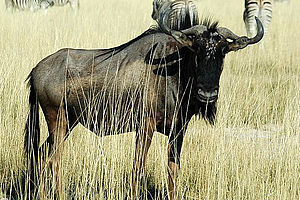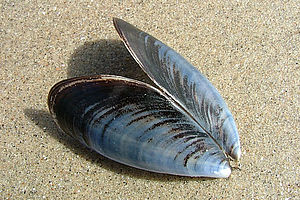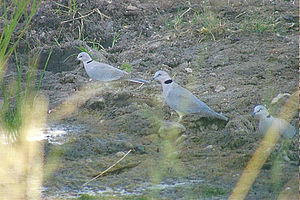More than half of a wildebeest’s life is spent resting, but being social animals, they too enjoy a little get–together.
Just what exactly does a wildebeest in Etosha National Park do all day and at night? A casual observer, after watching a solitary animal or a herd of these cousins of cattle, may say: “Well, they seem to mostly, graze, rest and sometimes drink water”. Indeed a correct impression of these peculiar antelopes, which typify the wildlife scene on the open plains of Namibia’s foremost refuge for wildlife. This impression is only part of the picture however, although wildebeest do spend the greatest portion of their sometimes-brief life either lying or standing motionlessly. Nevertheless, as a ruminant they possesses a four–chambered stomach that requires a regular supply of grass. Consequently, the apparently “resting” wildebeest is often busily engaged in circulating and digesting its food by “chewing the cud”.
Naturally, it takes a certain amount of energy simply to stay alive, even if an animal is lying resting. A living body must continue its basic processes of breathing, heartbeat, digestion, and maintain its temperature. This lowest form of activity is called “resting metabolism”. It is the most economical rate at which any animal can use energy and still stay alive and healthy. Any additional activity will therefore mean an increase in this “resting metabolic rate”.
How to measure the amount of energy a free–living wildebeest needs to survive the harsh environment of Etosha? A team of academics, comprising physiologists, biologists, veterinarians and statisticians were engaged over a period of a year to obtain this elusive answer. Applying well–tested formulae that are based on measurements of the energy used by domestic cattle, we adjusted these for the wildebeest’s way of life. Initially Etosha’s wildlife veterinarian temporarily immobilized a total of 70 wildebeest. They represented a random sample of the thousands of “gnus” that inhabit Etosha, including adults and immatures of both sexes. Brightly coloured, numbered collars were fitted around each animal’s neck, making it individually identifiable. Blood and tissues were taken from these and freshly–dead wildebeest, the latter when we located kills by lions. Such samples were needed by physiologists to complete the picture we were attempting to develop about the life of a wildebeest.
My part of the investigation was to follow the marked wildebeest for entire days and nights over a period of one year. Armed with binoculars, tape recorder and stopwatch, I relied on a four–wheel drive vehicle to keep up with the wildebeest herds as they led their lives. The statisticians were merciless in their requirements! They required literally several million samples of information, deciding that the best units for collecting this would be in the form of seconds, measured by stopwatch. Thus, my replays of the tapes sounded something like “wildebeest No. 10 is walking; stop walking after 23 seconds and stand resting; stop after 7 seconds and start grazing; stop after 35 seconds and start walking…”. This often-monotonous commentary continued for a period of 15 minutes, or 900 seconds, which was the longest that I could accurately monitor a marked animal without making significant mistakes on the stopwatch. I needed a further 15 minutes to rest and position my vehicle for the next 900–second recording session. It was imperative that the animal I was following was not influenced by my presence, as this would have resulted in an unnatural record of its activity.
Recalling this “Year of the Wildebeest”, I vividly remember days of blazing summer sun on the vast savannas, interspersed with cool, moonlit nights, when I would lose sight of a marked animal. This sometimes occurred when predators appeared on a hunt and the scene changed from one of placid grazing to panic as lions or spotted hyaenas created chaos among the herds. At other times, during the chill of winter’s long nights, I became so tired that I began falling asleep between bouts of recordings. Bleary–eyed and numbed to the bone I would return to Okaukuejo as the sun’s watery rays spread across the plains. I consoled myself with the thought that, at least, I had gleaned another 20 000 or more seconds from the wildebeest’s diary.
After a year the statisticians pronounced themselves satisfied with the quantity and the physiologists were satisfied with the quality of the information they had. It required a further year to analyze, interpret and produce a voluminous report. When it was ready it told the story that a wildebeest needs 10% more energy just to stand resting, compared to lying. Grazing needs 50% more energy than resting and walking consumes 70% more. The energy crisis in wildebeest occurs when they have to sprint for their lives to escape a hunting lion. This is when they use up to 8 times as much precious energy than when they were just “ticking over” at rest. Small wonder that wildebeest spend a very small percentage of their day on the run: only 0,6% or nine minutes to be exact.
The four basic requirements that a wildebeest must have to survive in nature are food, water, protection against the extremes of weather, and protection from predators. The painstakingly compiled diary reflects that a wildebeest spends 53% of its life resting and 33% foraging for grass. Enter a further 12% for movement, including the daily trip to a waterhole or perhaps a brief gallop. Less than 1% is spent actually drinking. Adding these entries, we see that nearly 99% is accounted for. What about the remaining quarter–of–an hour? Well, let’s be fair. If you or I had our day fully booked just to stay alive, wouldn’t we want to indulge in a little social activity? Wildebeest do just that. So, next time you visit Etosha and see two wildebeest bulls facing each other and pawing the ground or chasing a herd of comely cows, be understanding of their apparently comical behaviour. Remember, if your diary was 99% booked by earning your living, would you not want to enjoy yourself at a party now and again?










